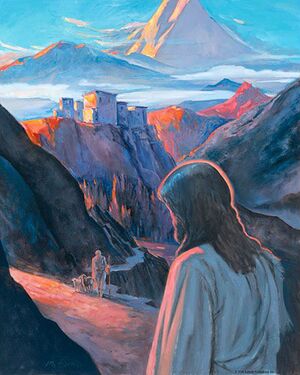Issa/fr: Difference between revisions
(Created page with "''L'étang d'Issa'', Nicholas Roerich (c. 1926)") Tags: Mobile edit Mobile web edit |
(Created page with "En 1887, un médecin russe, Nicolas Notovitch, se rend dans la ville tibétaine d'Himis, située dans la chaîne de l'Himalaya, à la recherche d'écrits anciens sur la vie d'un homme que les bouddhistes appelaient Saint Issa. Au monastère d'Himis, le lama en chef lui a lu d'anciens manuscrits et Notovitch a écrit l'histoire d'Issa, un Israélite qui s'est rendu en Orient pour étudier les écritures sacrées, puis est revenu enseigner à son peuple en Palestine, où i...") |
||
| Line 3: | Line 3: | ||
[[File:Issa-pond-le.jpg|thumb|upright|''L'étang d'Issa'', Nicholas Roerich (c. 1926)]] | [[File:Issa-pond-le.jpg|thumb|upright|''L'étang d'Issa'', Nicholas Roerich (c. 1926)]] | ||
En 1887, un médecin russe, Nicolas Notovitch, se rend dans la ville tibétaine d'Himis, située dans la chaîne de l'Himalaya, à la recherche d'écrits anciens sur la vie d'un homme que les bouddhistes appelaient Saint Issa. Au monastère d'Himis, le lama en chef lui a lu d'anciens manuscrits et Notovitch a écrit l'histoire d'Issa, un Israélite qui s'est rendu en Orient pour étudier les écritures sacrées, puis est revenu enseigner à son peuple en Palestine, où il a été crucifié. | |||
<div lang="en" dir="ltr" class="mw-content-ltr"> | <div lang="en" dir="ltr" class="mw-content-ltr"> | ||
Revision as of 11:42, 13 June 2025


En 1887, un médecin russe, Nicolas Notovitch, se rend dans la ville tibétaine d'Himis, située dans la chaîne de l'Himalaya, à la recherche d'écrits anciens sur la vie d'un homme que les bouddhistes appelaient Saint Issa. Au monastère d'Himis, le lama en chef lui a lu d'anciens manuscrits et Notovitch a écrit l'histoire d'Issa, un Israélite qui s'est rendu en Orient pour étudier les écritures sacrées, puis est revenu enseigner à son peuple en Palestine, où il a été crucifié.
The parallels between Saint Issa and Jesus were remarkable, leading Notovitch to conclude that the manuscripts provided the account, absent from the Bible, of Jesus’ life between age 13 and 30. He published the story of his discovery in 1890 in Life of Saint Issa (English trans. The Unknown Life of Christ, 1895). According to Notovitch, the original Pali manuscripts of the life of Saint Issa were in the library of Lhasa in Tibet where the Dalai Lama resided.
Critics claimed that Notovich’s account of the manuscripts was false. However, in 1922, Swami Abhedananda, a scholar and disciple of the Hindu Saint Ramakrishna, saw the same documents at Himis. Nicholas Roerich, Russian archaeologist, author, artist, philosopher saw the same, or similar, documents in 1925. Roerich also discovered Jesus’ journey to the East recorded in the oral history of the region. He said, “In what possible way could a recent forgery penetrate into the consciousness of the whole East?”
See also
For more information
Elizabeth Clare Prophet, The Lost Years of Jesus: Documentary Evidence of Jesus’ 17-Year Journey to the East.
Sources
Pearls of Wisdom, vol. 25, no. 58.
Elizabeth Clare Prophet, October 6, 1987.
